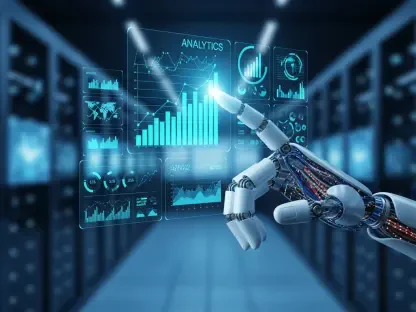Imagine a world where an advertising campaign that once took weeks to develop is crafted in mere hours, with tailored visuals and copy that resonate deeply with each viewer, thanks to the power of artificial intelligence. This is no longer a distant vision but a reality driven by AI, which is reshaping the advertising industry at an unprecedented pace. The integration of AI into creative workflows is not just streamlining processes; it is redefining how brands connect with audiences in a digital-first era. This report delves into the profound impact of AI on advertising, exploring its current applications, emerging trends, and the challenges and opportunities that lie ahead for agencies and marketers.
The Current Landscape of Advertising and AI Integration
The advertising industry has undergone a seismic shift in recent years, propelled by digital transformation and the explosion of online platforms. With consumers spending more time on social media, streaming services, and e-commerce sites, brands are compelled to create content that cuts through the noise. AI has emerged as a critical tool in this environment, enabling companies to navigate the complexities of digital marketing with greater efficiency and precision. From automated ad placements to real-time analytics, technology is becoming the backbone of modern advertising strategies.
Creative workflows, which encompass ideation, content creation, and campaign execution, are at the heart of this evolution. AI is proving to be a game-changer by unifying fragmented processes that once required extensive human input across multiple teams. Its ability to generate ideas, draft copy, and design visuals is reducing turnaround times and allowing for rapid iteration. This shift is particularly evident in key areas such as digital marketing, where targeted ads are crafted instantly, and media optimization, where algorithms fine-tune placements for maximum impact.
Major players, including tech giants, global agencies, and innovative brands, are driving this adoption, alongside a wave of emerging AI tools tailored for advertising. Companies are leveraging platforms that integrate text and visual generation, while startups are introducing solutions for everything from audio ads to 3D storytelling. As competition intensifies, the focus is on harnessing AI to deliver content that not only engages but also converts, setting a new standard for creativity in the industry.
Key Trends and Innovations in AI-Driven Advertising
Emerging Technologies and Creative Shifts
A notable trend in AI-driven advertising is the move toward unified workflows that consolidate disparate tasks into seamless processes. Automation is eliminating repetitive chores like resizing images for different platforms or drafting initial ad copy, freeing up creatives to focus on strategy and emotional resonance. Hyper-personalization is another significant shift, as AI analyzes vast datasets to tailor content to individual preferences, ensuring relevance in a crowded market.
Consumer behavior is also evolving, with audiences increasingly expecting content that feels bespoke and immediate. This demand for customization, coupled with market pressures for speed and scalability, is pushing agencies to adopt AI solutions that can produce diverse outputs at scale. The ability to test multiple campaign variations in real time is transforming how marketers approach audience engagement, making adaptability a core competitive advantage.
Moreover, AI is opening new creative frontiers by expanding into multimedia formats such as video, audio, and 3D design. These tools enable dynamic storytelling that captivates viewers through immersive experiences, from interactive ads to virtual product showcases. As technology advances, the potential for AI to craft narratives across various senses is redefining the boundaries of advertising, offering brands innovative ways to stand out.
Market Data and Growth Projections
Recent studies highlight the rapid adoption of AI in advertising, with the global market for AI-driven marketing solutions already valued at billions of dollars. Industry reports indicate that over half of major agencies and brands have implemented AI tools in some capacity, with usage expected to grow significantly from 2025 to 2027. This expansion reflects a broader recognition of AI’s value in enhancing operational efficiency and campaign outcomes.
Performance metrics further underscore AI’s impact, showing reductions in production times by up to 60% for certain creative tasks. Campaigns utilizing AI for personalization and optimization are also reporting improved return on investment, with some studies noting increases in conversion rates by double-digit percentages. These figures demonstrate how technology is not just a cost-saving measure but a driver of measurable business success.
Looking ahead, forecasts suggest that AI will penetrate deeper into creative workflows over the coming years, with generative models poised to dominate content creation. Analysts predict that by integrating predictive analytics, AI will enable even more precise targeting and real-time adjustments. This trajectory points to a future where technology becomes indispensable for staying competitive in an ever-evolving advertising landscape.
Challenges in Adopting AI for Creative Workflows
The integration of AI into advertising is not without hurdles, as concerns linger over its potential to displace jobs in creative fields. Many professionals fear that automation could diminish the human touch that often defines memorable campaigns, raising questions about the balance between efficiency and originality. Technical limitations, such as the inability of some AI tools to fully grasp nuanced cultural contexts, also pose barriers to widespread adoption.
Market-driven challenges further complicate the picture, particularly for smaller brands that may struggle with the upfront costs of implementing AI solutions. Traditional agencies, accustomed to established methods, often exhibit resistance to change, viewing technology as a threat rather than an ally. These financial and cultural obstacles highlight the uneven pace at which the industry is embracing digital transformation.
To address these issues, hybrid models that combine human oversight with AI capabilities are gaining traction as a viable solution. Training programs aimed at upskilling creative teams to work alongside technology are also essential, ensuring that staff can leverage tools effectively while preserving their unique perspectives. By fostering collaboration rather than replacement, the industry can navigate these challenges and maximize AI’s potential.
Regulatory and Ethical Considerations in AI Advertising
Navigating the regulatory landscape is a critical aspect of AI adoption in advertising, as data privacy laws like GDPR and CCPA impose strict guidelines on consumer information usage. These regulations aim to protect individuals from misuse of personal data, a cornerstone of AI-driven personalization. Compliance requires brands to prioritize security and consent, often necessitating significant adjustments to existing practices.
Ethical concerns also loom large, particularly regarding transparency in AI-generated content. Consumers are increasingly wary of manipulative tactics, prompting calls for clear disclosures when ads are crafted by algorithms. Striking a balance between leveraging data for customization and maintaining trust is a delicate challenge that agencies must address to avoid reputational risks.
The impact of these regulations extends to creative practices, as restrictions on data collection can limit the scope of personalization efforts. Brands are compelled to find innovative ways to engage audiences within legal boundaries, often turning to anonymized datasets or contextual targeting. As scrutiny intensifies, adherence to ethical standards will be paramount in shaping public perception and ensuring sustainable use of AI in advertising.
The Future of AI in Advertising Creative Workflows
Looking forward, AI is set to play an even more transformative role in advertising through advancements like generative models capable of producing multimedia content. These technologies promise to create everything from full-length video ads to interactive experiences with minimal human input, pushing the boundaries of what is possible in campaign development. The potential for automation to handle complex creative tasks is vast, offering a glimpse into a highly efficient future.
Potential disruptors, such as shifting consumer preferences for authenticity over polished content, could influence AI’s trajectory. Global economic fluctuations may also affect investment in technology, particularly for smaller players. Despite these uncertainties, the emphasis on real-time analytics and deeper integration of data into creative processes is likely to drive continuous innovation, ensuring that AI remains a central focus.
Growth areas are abundant, with the democratization of creative tools empowering small businesses to compete with larger counterparts through accessible AI platforms. Enhanced analytics will further enable brands to optimize campaigns on the fly, responding to audience feedback instantly. As these developments unfold, the advertising industry stands on the brink of a new era where technology and creativity converge in unprecedented ways.
Conclusion: Embracing AI for a Competitive Edge
Reflecting on the insights gathered, it becomes evident that AI has fundamentally altered advertising workflows by delivering remarkable efficiency gains, enabling deeper customization, and providing actionable data-driven insights. The journey through emerging trends and persistent challenges paints a picture of an industry in transition, balancing innovation with tradition. Agencies and brands that harness AI strategically find themselves better positioned to navigate a dynamic market.
Moving forward, the focus should shift to actionable steps that ensure sustainable integration of AI. Investing in training initiatives to bridge the gap between human creativity and automation emerges as a priority, alongside fostering transparent practices to build consumer trust. By embracing adaptability and championing ethical standards, the industry can unlock AI’s full potential, paving the way for groundbreaking campaigns that resonate on a global scale.









